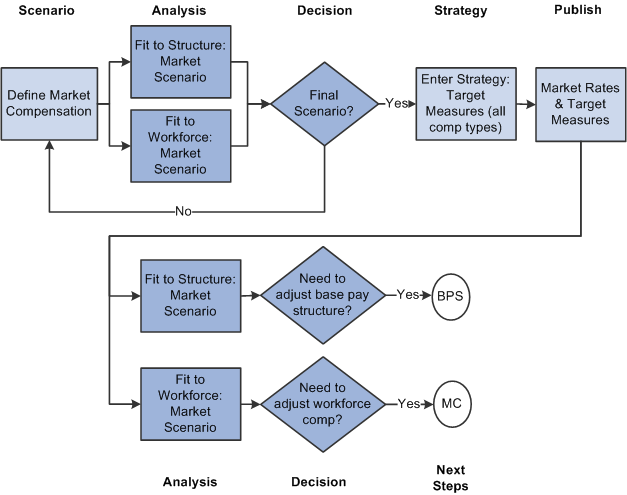Understanding the Market Compensation Module
This section discusses:
The Market Compensation module.
The Market Compensation business process.
Base currencies.
Trees.
The Market Compensation Module
Managing market compensation means analyzing your organization's compensation strategy, by job and pay structure. You collect market compensation data from external survey sources, to compare the data against your organization's existing pay structures and compensation strategy. This requires an understanding of what your organization's compensation strategy is for these jobs. For example, does your organization want to meet the 50th percentile market rate for the regular base compensation for a job and use aggressive incentives to allow workers to exceed the 50th percentile for total cash compensation? Or does your organization want to match the 50th percentile market rate for cash compensation for jobs requiring essential technological and managerial skills, and then meet the 40th percentile market rate for the remainder of the jobs? Gain a clear understanding of these issues and identify your organization's compensation strategies.
The process of defining market compensation rates involves:
Matching your organization's jobs to similar benchmark jobs that appear in published compensation surveys.
Developing market rates for the jobs.
Comparing your organization's compensation rates to the market rates.
Determining target market rates for your pay programs.
Jobs that are common across industries (or within an industry) and that appear in published survey sources are benchmark jobs (or benchmarks). They provide a basis for comparison against similar jobs in your organization. Jobs in your organization for which there are no corresponding benchmarks are termed non-benchmark jobs.
Market rates are the best estimate of the external market value of a job, that is, the prevailing compensation rate for the job in the labor market. The market compensation process typically involves these steps:
Import relevant survey data into the system.
Transform the survey data to meet your predefined dimensions and requirements.
Transform the survey data to update data from multiple sources to a common date, or age old data to the present date.
Calculate market rates for each benchmark job based on a weighted average from selected survey samples.
Conduct analyses to compare current organization pay programs and actual pay levels to the market.
The Market Compensation Business Process
Image: Market Compensation business process
This diagram shows the main steps in the Market Compensation business process.

Base Currencies
PeopleSoft EPM applications require that there can be only one business unit per scenario, and that every business unit can have only one base currency code. Therefore, every scenario can have only one base currency code.
You must import external compensation survey data that is in the same base currency as that for the business unit that you are using in your scenario.
Trees
In Workforce Rewards, you use trees to provide structure to all of the main dimensions (department, geography, compensation code, job code, financial size, unit size, and industry type). You can have multiple versions of these trees in your system, with different names.
In the Market Compensation module, use the trees specified on the Mapping Tree Names page. When you specify a tree on this page, the tree mapping value must remain constant. The value must remain unchanged, from the start of your external survey data import, until you are finished using the survey data to generate a market compensation scenario.